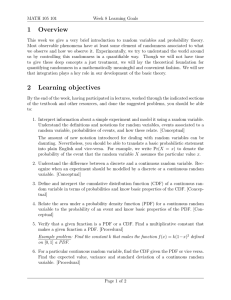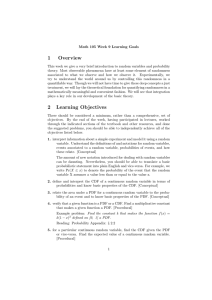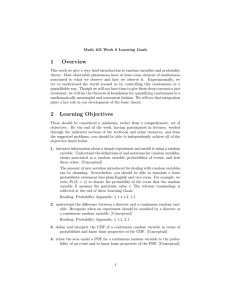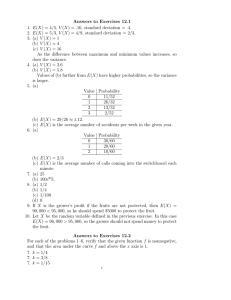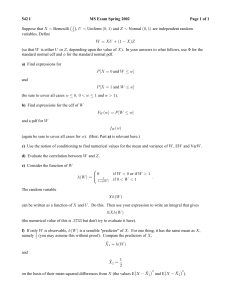Math 105 Course Outline Overview Week 9
advertisement
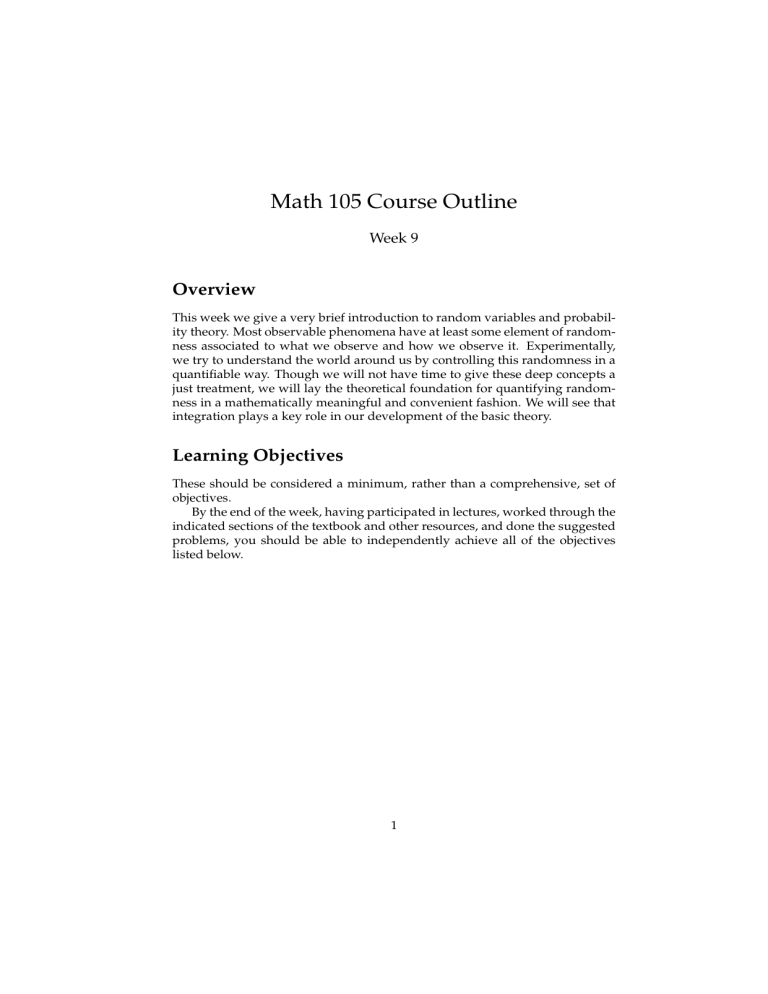
Math 105 Course Outline Week 9 Overview This week we give a very brief introduction to random variables and probability theory. Most observable phenomena have at least some element of randomness associated to what we observe and how we observe it. Experimentally, we try to understand the world around us by controlling this randomness in a quantifiable way. Though we will not have time to give these deep concepts a just treatment, we will lay the theoretical foundation for quantifying randomness in a mathematically meaningful and convenient fashion. We will see that integration plays a key role in our development of the basic theory. Learning Objectives These should be considered a minimum, rather than a comprehensive, set of objectives. By the end of the week, having participated in lectures, worked through the indicated sections of the textbook and other resources, and done the suggested problems, you should be able to independently achieve all of the objectives listed below. 1 Ref Online Notes Learning Objective Random Variables and Probability Objective 1: Interpret information about a simple experiment and model it using a random variable. Calculate and interpret probabilities of events for the random variable. [Conceptual] Example problem: Toss a fair coin two times and observe the number of “heads”. How likely is it to observe at least one “tails”? Reading: Online Notes §1.1 – 1.2, 1.5 Practice problems: Online Exercises #1 – 4, 22, 23 Objective 2: Understand the definitions of and notations for random variables, events associated to a random variable, probabilities of events, and how these relate. [Conceptual] The amount of new notation introduced for dealing with random variables can be daunting. Nevertheless, you should be able to translate a basic probabilistic statement into plain English and vice-versa. For example, we write Pr(X = x) to denote “the probability of the event that the random variable X assumes the particular value x”. The relevant terminology is collected at the end of these Learning Goals. Reading: Online Notes §1.2 Objective 3: Understand the difference between a discrete and a continuous random variable. Recognize when an experiment should be modeled by a discrete or a continuous random variable. [Conceptual] Reading: Online Notes §1.1, 2.1 2 Ref Online Notes Learning Objective Probability Density Functions (PDF) and Cumulative Distribution Functions (CDF) Objective 1: Define and interpret the CDF of a discrete or continuous random variable in terms of probabilities and know basic properties of the CDF. [Conceptual] Objective 2: Relate the area under a PDF for a continuous random variable to the probability of an event and to know basic properties of the PDF. [Conceptual] Objective 3: Express a probability density function (PDF) or a cumulative distribution function (CDF) of a discrete or continuous random variable in a graph, table, or as an explicit function, given sufficient information about the random variable. [Procedural] Example problem: Consider rolling a pair of six-sided dice. Let X denote the sum of the face-values of the two dice. Construct a table for the PDF of X. Reading: Online Notes §1.3 – 1.5, 2.1, 2.3 Practice problems: Online Exercises #1, 3, 4a,b, 6a, 21c,d, 24c,d, 25a, 31 Objective 4: Verify that a given function is a PDF or a CDF. Find a multiplicative constant that makes a given function a PDF. [Procedural] Example problem: Find the constant k that makes the function f (x) = k(1 − x)2 defined on 0 ≤ x ≤ 1 a PDF. Reading: Online Notes §2.2, 2.4 Practice problems: Online Exercises #9, 11, 13, 15 – 17, 21a, 24a, 30a Objective 5: For a particular random variable, find the CDF given the PDF or vice-versa. [Procedural] Example problem: If the random variable X is given by the PDF f (x) = |x| on −1 ≤ x ≤ 1, find the CDF of X. Reading: Online Notes §2.4 – 2.5 Practice problems: Online Exercises #10, 12, 14 3 Ref Online Notes Learning Objective The Normal Distribution Objective 1: Calculate probabilities of events associated to normal random variables by standardizing and using given information about probabilities of events associated to the standard normal random variable. [Procedural] Note: Students do not need to memorize the formula for the probability density function of a normal random variable. Reading: Online Notes §2.6 Ref Online Notes Practice problems: Online Exercises #27 – 29 Learning Objective Expectation, Variance, Standard Deviation Objective 1: Define and interpret the expectation, variance and standard deviation of a discrete or continuous random variable. [Conceptual] Objective 2: Calculate the expectation, variance and standard deviation of a given discrete or continuous random variable. [Procedural] Example problem: If the PDF of a random variable X is given by the function f (x) = λe−λx for x ≥ 0 and some λ > 0, compute the expected value and standard deviation of X. Reading: Online Notes §1.6 – 1.7, 2.8 Practice problems: Online Exercises #1, 2c, 5, 7–8, 18–20, 21b, 24b, 25b, 26, 30b,c, 32 4 Ref Larning Objective Online Notes List of Terminology Random Experiment: An experiment, trial or measurement of some undetermined quantity that can be repeated (possibly with different outcomes) under the same conditions. Random Variable: A theoretical representation of an experimental process. More precisely, a random variable is a quantity without a fixed value, but which can assume different values depending on how likely these values are to be observed. These likelihood values are given by a probability distribution. Event: A collection of possible outcomes of a random variable. Probability of an Event: The likelihood of observing the event, given a random variable. Given an event A, we write Pr(A) to denote the probability of this event. Discrete Random Variable: A random variable that can assume only finitely many (or countably many) values. Continuous Random Variable: A random variable that can assume any value in a continuum of values (for example, an interval), but that assumes any single, particular value with probability zero. Cumulative Distribution Function (CDF): For a random variable X, the CDF of X is the function F (x) defined by F (X) = Pr(X ≤ x), for all x. Probability Density Function (PDF): For a continuous random variable X, the PDF of X is the function f (x) that satisfies F (x) = Rx f (t)dt for all x. −∞ Expectation or Expected Value: For a continuous random variR∞ able X, E(X) = −∞ xf (x)dx, where f is the PDF of X. Variance: For a continuous random variable X, Var(X) = R∞ 2 [x − E(X)] f (x)dx, where f is the PDF of X. −∞ Standard Deviation: The positive square root of the variance. 5
